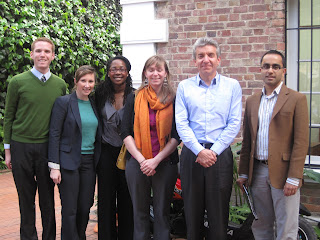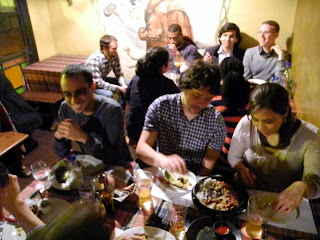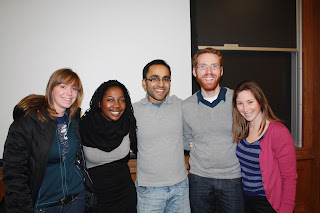Four of our groups had a unique opportunity to hear union leaders talk about current conditions for workers in Colombia. We visited the union's headquarters for lunch and listened to two presentations by labor rights activists, who offered perspective on recent free trade agreements and some ongoing labor disputes -- for example, with Coca-Cola and Nestle.
It is often very difficult for workers to organize in Colombia because only a portion of them are legally allowed to do so. Often labor laws trump union rights, the union leaders said. It can also be flat-out dangerous to be involved with unions: According to one presenter, over the years this particular group has seen 25 of its members assassinated, 18 jailed and 7 driven from the country.
Later, many of us enjoyed a visit with
Escuela Nueva, where the conversation was more positive, focusing on successful improvements to education. Founder Vicky Colbert explained that much of the education NGO's philosophy has revolved around "learning for change" -- encouraging low-income areas to adopt modern pedagogical methods, such as collaborative learning and community engagement.
Latin America's education system is still very teacher-centric, Colbert said. A teacher from 100 years ago would not be lost in one of today's classrooms. But thanks to some simple tools, training and knowledge-sharing networks produced by Escuela Nueva, teachers are learning how to better serve their students.
 |
| Jeff and Naveen with one of our dinner guests. |
Our day ended with a terrific dinner with several representatives of the public sector in Bogota. Besides sharing details of their work with us, many of them offered suggestions for fun things to do in Cartagena -- our next destination tomorrow afternoon.
For more pictures from our dinner party, visit us on
Facebook.
- Lindsay
Dispatch from the social policy team
The day began at Hospital Universitario San Ignacio with a conversation about Colombia's health care delivery system with a professor of medicine. He criticized
La Ley 100 because it deprioritized primary care services and public health interventions, resulting in a rise of communicable and chronic diseases. He explained how the incorporation of insurance companies using fee-for-service payment has led to the fragmentation of health care delivery. Insurance companies urge patients to pick and choose parts of their health care depending on which provider within their network provides a particular service (e.g. diagnostics, treatment, follow-up, rehabilitation, etc.) for a lower price, rejecting the idea of comprehensive, patient-centered health care which has proven to reduce costs by at least 20%.
When the conversation transitioned to a discussion about racial health disparities and diversity in the health care workforce, the doctor had less to say. However, he insisted that there was no discrimination against Afro-descendants in universities and that it was actually easier to get social services if one identified his/herself as a minority. To further his argument, he identified a medical student of African descent at the university who was especially "brilliant and interesting."
For lunch we made our way to the Office of the President to meet with the director of the Agency for the Reduction of Extreme Poverty which is housed in the Department of Social Prosperity. He described their innovative program
Reunidos that combines social work, private-public partnerships, and social innovation initiatives to eradicate extreme poverty. When describing income generation activities geared toward Afro-descendants, he explained how Afro-descendants were especially talented in "culture and sports" in addition to other unnamed "industries".
Later that afternoon we made our way back to Pontificia Universidad Javeriana to meet with a professor of health policy and the former secretary of health in Bogotá. Though he is a medical doctor, he insists that his primary role in Colombia is as a social activist. He discussed Colombia's denial of racial discrimination and institutionalized racism in his personal and professional experiences. He discussed his efforts to improve primary care in Colombia and his research on social and environmental determinants of health. He has started projects that promote urban rejuvenation and "city health" in order to improve the living conditions of Colombia's poor as a means to improve their health status.
- Ine
Dispatch from the human rights team
In a hectic day at the office, the human rights group met first with a Colombian NGO working primarily with the multisectoral issues surrounding displacement and the needs of displaced populations. The group's research suggests that a connection exists between military presence and displaced populations. Through the lens of human rights, the group has observed the disproportionate number of homicides, incidents of violence, and number of active paramilitary groups in departments most affected by displacement.
The group has seen, as in other cases of internal displacement, that official processes and channels of recognition for displaced persons. With the environment team, the group discussed consequences for the health and education for displaced families, and the gaps left unaddressed by legislation on the subject. By independent estimates, between 1985 and 2011, a staggering 5.494 million Colombians have been displaced, mainly due to conflict, which in turn is sustained and financed through resource exploitation by responsible groups.
The afternoon meeting, attended by the larger group, was with a prominent union representing workers from 60 companies. The group has researched the difficulties of unionization and the trends in membership and activities in Colombia. Unions in Bogota have worked to raise awareness and pursue legal cases against major companies.
The group’s final meeting was perhaps the most pertinent to the research topic – with
Grupo Memoria Historica. The team was able to obtain valuable perspectives on the origins and foundations of GMH, including early concerns such as dilemmas on appropriate methodologies to be used in the collection ofhistorical memory.
GMH’s choice of emblematic cases, the team learned, was basedon an assessment of key factors present in different degrees in the relevant cases,such as presence and degree of conflict, involved groups, or indigenousidentities. The key aspect was not just to collect statistics on human rights atrocities but also to examine the impact of violence on victims and families.The goal was to create an indigenous effort that operated under the collective definition of justice. The meeting was particularly relevant for it spoke tothe difficulties inherent in the process of historical memory, such as logistical and security issues in gaining access to victim groups and the ideaof beginning this process while the conflict persisted. The team also learned of the process through which the GMH reports were drafted and finalized throughcommunity participation, and how the reports have become incorporated intocontemporary art forms.
GMH is in the process of being transformed into the Center for Historical Memory with the mandate to archive and provide symbolicacknowledgement to the atrocities of Colombia’s past.
- Emad
Dispatch from the security team
The security team began early by meeting with Fundacion Ideas para la Paz. Founded in 1998, the think tank is committed to monitoring conflict, negotiations, post-conflict, business sector, and security/police issues. This was a good opportunity for us to talk to two experts on the Bacrims. In our conversations with them, they discussed the origins of the Bacrims as they had evolved from the paramilitary groups in Colombia. They, too, referred to the Bacrims as neo-paramilitary groups because of much of the same leadership and membership in these older incarnations. Our hosts also reiterated the importance of the government addressing the Bacrims as well as the FARC.
 |
| Our host at Corporation Arco Iris explains the origins of the Bacrim. |
We also visited Corporation Arco Iris and got even more insight on the Bacrims. There, we got a comprehensive (and even a little intense) overview on the history of the guerrillas, paramilitary groups, and the Barcims. In our discussion, we also learned about the techniques, tactics, and procedures of these various groups, and then focused particularly on the Bacrims as our research paper will mainly focus on that. The conversation went really well, although we suffered from the "fire hose effect" with so much information being thrown at us. Nonetheless, a fascinating meeting and discussion.
- Neal
Dispatch from the environment team
The environment group made the most of the leap year with three planned and one impromptu meeting, as well as the discovery of a delicious hole-in-the-wall café and a sweater-wearing Chihuahua. In the morning we tagged along with the human rights group to meet an NGO that compiles information on displacement in Colombia, often coming up with distinct numbers than those released by the government. The group relayed that the “post-conflict” development narrative now being told about Colombia often masks the narrative of continuing violence and human rights violations in the country—something to keep in mind in our research on the biofuel industry.
Our lunch talk with a unionist coalition based in Bogotá, snowballed us to another contact and afternoon meeting (theimpromptu one foreshadowed earlier). But first came the café, where we drank creamy hot chocolate and listened to the rain while sitting in beautiful wooden chairs made by the owner who later lent us his laptop. Muy amable.
Our (first) afternoon meeting was with Fedepalma, the palmgrowers association of Colombia, where we met with an environmental expert and a social development expert. The two were extremely knowledgeable, and we touched on a wide range of topics, from employment to the Free Trade Agreement to targeted expansion of the agricultural frontier. We learned more about the recent life cycle analysis of the biofuel industry in Colombia, which determined biofuel’s carbon footprint as compared to diesel. Not counting indirect land use change, biofuels represent an 83% reduction in emissions from diesel; counting indirect land use change, the figure is still at least a 46% reduction—still well above the European standard of 35%. Though he acknowledged that palm plantations span the spectrum of excellent to poor management, the social development export noted that Fedepalma is working towards helping all plantations run at a high level of efficiency in terms of resource use.
Our final meeting of the day was with a human rights non-profit. We met with a lawyer who has worked on the (in)famous Las Pavas case in the northwest of the country, where the population (120 families, according to a recent news report) were displaced from their land three times by violence and returned three times. Upon the second return, they found the land covered in palm, a crop that uses a lot of water and does not fit with the community’s farming and fishing traditions. In the news, these
campesinos have been accused of taking advantage of land reparation laws to claim territory that was never theirs, but our host
told a story of
palmeros delegitimizing community leaders and intimidating the population. So, as our research deepens, our understanding of the social and environmental impacts of the palm industry is both clarifying and complicating.
- Allie
Dispatch from the business and trade team
 |
| The business and trade team at Fundacion Ideas para la Paz. |
The business and trade team started our day at the Fundación Ideas para la Paz, which was founded in 1999. Fundación focuses on developing the business industry by recommending guidelines and best practices to assist companies via research and technical assistance. This assistance mostly takes place in rural communities, specifically in locales where multinational corporations (MNCs) may initially be met with suspicion. In the past, this suspicion led community members to block the roads to keep out companies. However, with the guidance of Fundación, the corporation met with communities members. This meeting led the company to provided training and jobs, which led to a mutually beneficial relationship for the corporation and local community members.
Worker training in Colombia is unique in that the nation is conflict and post-conflict simultaneously. Thus, ex-combatants must be reintegrated into society so that they will not return to guerrilla warfare or coca farming. In training combatants companies also limit the amount of violence carried out in the communities where they are working. Ensuring human rights become good for business and not just a part of corporate social responsibility (CSR).
After meeting with the union with the larger group, we headed over in the rain to Proexport to meet with Camilo Andres Ayala Patino. Proexport falls under the Ministry of Commerce, Industry and Trade and has 24 international offices. The goal of the organization is to increase Colombian exports around the globe. In 2012 Proexport's focus is regionalization of trade. This will be accomplished by sharing information about international markets with businesses, offering export training and adapting Colombian businesses so that they can be successful in the international market.
Camilo stressed the importance of education for business owners. Once owners learn how to effectively package, brand, and prepare for international logistics, they can more successfully integrate into the global market. In the era of the Free Trade Agreement (FTA), successful market integration is especially important as companies with more exposure to international trade will be more successful in competing with global organizations.
After leaving Proexport we had time for a cup of coffee and then headed to Escuela Nueva to learn about the meaningful work being done by Vicky Colbert and teachers around the world. Our jam-packed day ended with a delicious dinner at Tabula with policy leaders. Whew! This is our last full day in Bogota. Tomorrow we will be heading to Cartagena. Stay tuned!
- Kyasha




























